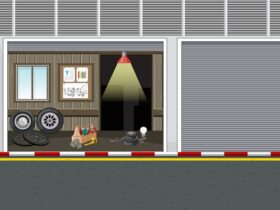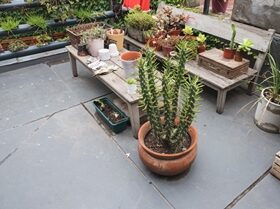Creating a beautiful garden isn’t just about planting flowers or maintaining a lush lawn—it’s also about finding unique ways to frame and define your outdoor space. One effective approach is to use creative garden edging ideas. In this comprehensive guide, we’ll explore a variety of inexpensive and imaginative ways to add visual interest to your garden using edging. Whether you prefer a classic, modern, or rustic look, you’ll find something to inspire your landscaping project.
Why Garden Edging Matters
Garden edging serves a variety of purposes. It helps define the boundaries of your garden, separates different types of plants, and creates a polished appearance. Moreover, edging can prevent the spread of grass and other invasive plants into your flower beds, reducing the need for maintenance. Let’s delve into some of the most effective and affordable garden edging ideas to transform your outdoor space.
1. Brick and Stone Edging
Brick and stone are classic garden edging materials that offer durability and a timeless aesthetic. Brick edging can be laid in various patterns, such as herringbone or basketweave, creating a visually appealing border. You can also use bricks to create curves or straight lines, depending on your garden’s layout.

Stone edging is another popular choice. You can use natural stones of different sizes and shapes to create a rustic look. Large flat stones can be stacked to form a sturdy border, while smaller pebbles can create a more subtle effect. This type of edging is ideal for gardens with a natural or cottage-style theme.
2. Wooden Edging
For a more rustic or country-inspired look, wooden edging is an excellent choice. You can use wooden logs, railway sleepers, or even reclaimed wood to create a charming garden border. Wooden edging is versatile and can be cut into various shapes and sizes, allowing you to customize your garden’s appearance.

One popular approach is to use bamboo edging. Bamboo is lightweight, sustainable, and easy to work with, making it an eco-friendly option. You can create a simple border by driving bamboo stakes into the ground or use bamboo poles for a more substantial edge.
3. Recycled Material Edging
If you’re looking for a budget-friendly and environmentally conscious option, consider recycled material edging. This approach allows you to repurpose everyday items, reducing waste and adding a unique touch to your garden.
Here are a few ideas
- Recycled glass bottles:
Arrange them in the ground, neck-down, to create a colorful and whimsical border. This technique works well for gardens with a bohemian or eclectic style.
- Old tires:
Cut tires into sections and use them to create a bold, contemporary edge. You can also paint them to match your garden’s color scheme.
- CDs and DVDs:
Line them up in a row to create a shiny and reflective garden border. This idea adds a touch of sparkle to your outdoor space.
4. Metal Edging
For a sleek and modern look, metal edging is a great choice. You can find metal edging in various finishes, including galvanized steel, aluminum, and corten steel, each offering a unique aesthetic. Metal edging is durable, weather-resistant, and can be shaped into different forms.
Corten steel is particularly popular due to its rustic appearance. As it ages, it develops a unique patina, giving your garden a warm and inviting feel. Metal edging is ideal for creating clean lines and crisp edges, making it perfect for contemporary garden designs.
5. Living Edging
For a more organic approach, consider using living edging. This method involves planting low-growing plants or grasses along the edges of your garden beds. Living edging adds a touch of greenery and can be tailored to suit your garden’s style.
Boxwood hedges are a classic choice for living edging. They can be trimmed to create precise shapes, giving your garden a formal look. Lavender, on the other hand, offers a fragrant and colorful border that attracts pollinators like bees and butterflies.
Mondo grass and creeping thyme are low-maintenance options that provide a soft and lush edge to your garden beds. These plants are hardy and require minimal care, making them ideal for busy gardeners.
Frequently Asked Questions about Garden Edging
Yes, you can use a wide variety of materials for garden edging, including brick, stone, wood, metal, plastic, and recycled materials. The choice depends on your garden’s style, budget, and personal preference. When choosing materials, consider their durability, weather resistance, and aesthetic appeal to ensure they meet your garden’s needs.
It’s recommended to inspect your garden edging at least once a season to ensure it remains in good condition. Check for signs of wear and tear, such as cracks in bricks, rust on metal edging, or rot in wooden edging. Address any issues promptly to prevent further damage and maintain a tidy garden appearance.
DIY garden edging projects can range from simple to complex, depending on the materials used and the design you choose. Basic projects like using bricks, stones, or recycled materials require minimal tools and skills. However, more intricate designs involving custom-cut wood or metal may require specialized equipment and experience. If you’re unsure, start with a straightforward project and gradually work your way up to more complex designs.
Using recycled materials for garden edging can have a positive impact on the environment by reducing waste and repurposing items that might otherwise end up in landfills. By recycling and reusing, you can contribute to sustainability efforts while adding unique and creative touches to your garden. Just ensure the materials are safe for outdoor use and won’t release harmful substances into the soil.
Yes, you can mix and match different types of garden edging materials to create a unique and personalized look for your garden. Combining materials like brick and stone, or wood and metal, can add visual interest and texture to your outdoor space. When mixing materials, consider their compatibility in terms of durability and style, and aim for a cohesive design that complements your garden’s overall theme.
Conclusion
Garden edging is an essential component of any well-designed outdoor space. Whether you prefer a classic brick border, a rustic wooden edge, or a contemporary metal look, there’s an edging solution that suits your style and budget. By incorporating some of these creative garden edging ideas, you can transform your garden into a stunning and well-defined oasis.











Find Us on Socials